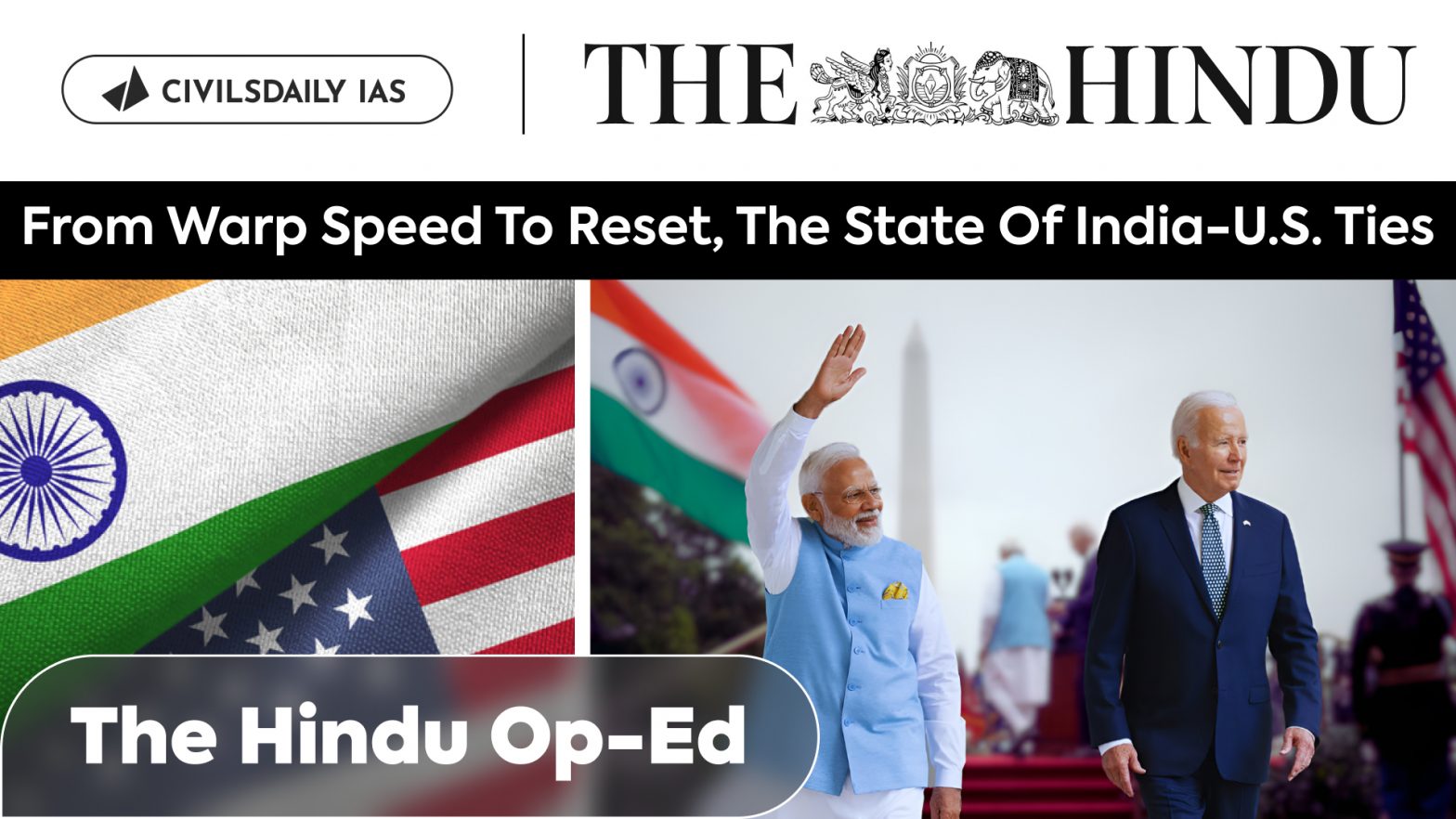| PYQ Relevance: Q How will the I2U2 (India, Israel, UAE and USA) grouping transform India’s position in global politics? (UPSC IAS/2022) Q Quadrilateral Security Dialogue (Quad) is transforming itself into a trade bloc from a military alliance, in present times Discuss. (UPSC IAS/2020) |
Mentors comment: A year after Prime Minister Narendra Modi’s state visit to the United States, marked by promising announcements of strategic cooperation, progress in the U.S.-India relationship has fallen short of expectations due to various internal and external factors. As Indian and U.S. leaders prepare to meet at the G-7 outreach summit and for bilateral discussions in Delhi, the dynamics of the relationship warrant careful examination.
Let’s learn …
Why in the News?
- A year ago, Prime Minister Narendra Modi’s state visit to the U.S. marked a significant moment in U.S.-India relations, with announcements on strategic and high-tech cooperation.
India-US Relations: One-Year Review
- iCET Initiative: The U.S.-India initiative on Critical and Emerging Technology (iCET) was a highlight, aiming to usher in a new phase in bilateral ties.
- Slow Progress: However, a year later, the relationship’s progress has been slower than anticipated due to various external and internal factors.
- Current Engagement: As Modi engages with U.S. President Joseph Biden at the G-7 outreach summit in Italy, it’s crucial to examine the “good, the not-so-good, and what could become ugly” in the relationship.
Significance of the ties
- Historical turn-around: Last September marked 25 years since the turnaround in ties post-Pokhran, initiated by Prime Minister Atal Bihari Vajpayee’s speech in 1998, calling India and the U.S. “natural allies.”
- Strategic Strengthening: Strategic ties have strengthened over the years, with dialogues in numerous areas including climate change, green energy, critical and emerging technologies, and outer space.
- Growing Trust: Over the past decade, strategic trust has grown, marked by foundational agreements, military exercises, interoperability, coordination on maritime operations, and significant military hardware purchases.
- De-hyphenation and Engagement: The de-hyphenation of U.S.-India ties with Pakistan, silence on Jammu-Kashmir issues, India’s increased engagement with the Quad, and shared concerns over China’s aggression have brought Delhi and Washington closer.
Contention: India’s neutrality over Russia
Despite thriving bilateral engagement, some areas remain work in progress:
- Russia’s War in Ukraine: Multilateral cooperation on global conflicts, such as Russia’s war in Ukraine, remains a major area of difference. The U.S. frames the war in terms of international rule of law and humanitarian principles, while India considers the disruption to the Global South, including food, fertilizer, and energy security.
- Compromises and Delays: The U.S. has compromised by withdrawing objections to India’s continued purchase of Russian oil and exports, while India has delayed the annual India-Russia summit for two years.
- Moral Stance: U.S. support for Israel’s actions in Gaza and continued civilian casualties has somewhat mitigated its moral stance.
What led to the recent souring of ties?
- Logistical Challenges in the South China Sea: On multilateral fronts, particularly concerning China’s threats against Taiwan and the South China Sea, India-U.S. cooperation at the Quad has faced logistical challenges:
- Decline of R-Day Invitation: President Biden’s decision to decline the invitation for India’s Republic Day in 2024 meant the Quad Summit was foregone and rescheduled after the U.S. elections in November.
- Others:
- Gaza Impact: Planned visits by U.S. National Security Adviser Jake Sullivan were cancelled due to the Gaza crisis, affecting the iCET review and other high-level visits.
- Manipur: There has been no Indian Ambassador in Washington for months, and ties with U.S. Ambassador to India Eric Garcetti are strained over comments on Manipur and human rights.
Tensions over ‘Terrorist’s Assassin Plots’
- Assassination Plot: The attempted assassination of Khalistani separatist and U.S. citizen Gurpatwant Singh Pannun in New York, allegedly ordered by Indian security officials, remains a significant issue:
- Impact on Relations: The plot in the U.S. and the killing of Canadian citizen Hardeep Singh Nijjar have caused discomfort in U.S.-India relations.
- Public Accountability: Concerns over India’s alleged involvement in the killing of foreign citizens in friendly countries have impacted the relationship.
- Public Demand: The U.S. demand for India to publicly account for the plot is a non-starter, but India’s theory of “rogue actors” will not suffice either.
- Escalation Potential: The issue is expected to escalate as more details emerge during the trial in New York and Canada.
Future Prospects
- Adjusting to Realities: The Indian government must adjust to new coalition realities after the general election results and engage with the U.S. before it enters “lame-duck” season.
- Possible Presidency: A possible Trump presidency in November might resolve some issues but introduce more uncertainty.
- Necessary Engagement: The opportunity for a Biden-Modi meeting and Sullivan’s visit to Delhi for the iCET review is crucial for a necessary restart in the relationship, a year after it seemed to have reached “warp speed.”
Conclusion
The India-U.S. relationship is at a crucial juncture, with significant potential for growth but also substantial challenges to overcome.The future path of U.S.-India relations will depend on both countries’ ability to navigate complexities, foster trust, and prioritize mutual interests for a stable and prosperous partnership.

